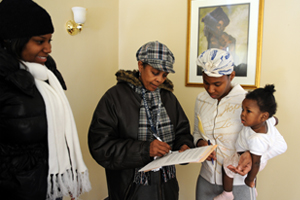How to institute change
Social scientists establish the Urban Network to share lessons and information that strengthen antipoverty programs.
By Elizabeth Station
Photography by Dan Dry

Sharing data could help social services such as the University’s immunization program.
To move beyond the social-sciences cliché that institutions matter, many scholars of urban poverty want to pinpoint how, why, and when they matter most—and work best—for the urban poor. At a March conference, they gathered in Ida Noyes Hall with that goal.
“Urban poverty could be addressed more effectively if we paid greater attention to the organizations that help structure people’s lives,” said Mario Small, a Chicago sociologist who helped to convene “Rethinking Urban Poverty for the 21st Century: Institutional and Organizational Perspectives.” “There’s an entire body of work in which the organization, rather than the individual or the neighborhood, is the unit of analysis that could inform these questions in interesting ways.”
Increasingly, community-based nonprofits, such as health clinics, charter schools, and immigrant organizations, find themselves on the front lines of delivering social services in cities. Sociologists, political scientists, economists, and public-health researchers have scrutinized the results. But they haven’t always shared lessons and data with each other or with the people who run antipoverty programs.
To bridge those gaps, Small and Scott W. Allard, an associate professor in the School of Social Service Administration, co-organized the conference. The gathering also launched the University of Chicago Urban Network, a project that aims to spark dialogue on urban research, theory, and policy.
With 220 attendees, the event got the network off to a promising start. Participants included professors, graduate students, public-school administrators, health-service officials, teachers, and advocates for the poor. “I was surprised by the vast array of people with strong interests in attending what was ultimately an academic conference,” said Small, who directs the Urban Network.
Small took an in-depth look at organizations in Unanticipated Gains (Oxford University Press), a 2009 book that explores how child-care centers help New York City mothers expand the size and usefulness of their personal networks. At the conference, presenters offered their own case studies of how institutions shape daily life for the urban poor.
Northwestern University sociologist Celeste Watkins-Hayes, for instance, discovered that churches, drug and alcohol rehab centers, and AIDS service organizations all play a critical role for Chicago-area women with HIV/AIDS. Such “framing institutions” help women learn to understand and accept their changed health status, “manage the disease symptoms and problems, and integrate HIV into their everyday lives.” Women who lack access to those services are often unable to conquer depression, drug use, and other challenges after their diagnosis, Watkins-Hayes found—to the point where they may see themselves as “dying from,” rather than “living with,” the disease.
Not all institutions have such a positive impact. Ineffective, corrupt, or unresponsive organizations can worsen inequality. Stefanie DeLuca, AB’97, a sociologist at Johns Hopkins, offered housing as an example. Since the early 1990s, efforts to assist low-income families have included rent vouchers to help them leave high-poverty areas. But when DeLuca studied households in Baltimore and Mobile, Alabama, she found that “voucher policies may be creating horizontal rather than vertical ghettos.” Facing discrimination from landlords and inadequate time under voucher-program rules to relocate to better homes or neighborhoods, poor families often fail to “move to opportunity,” DeLuca argued. And because the local public-housing authorities that administer the vouchers fear losing federal money, they have a built-in disincentive for helping such families to do so.
Other speakers highlighted institutional success stories. In cities around the country, affiliates of the Restaurant Opportunities Center and the National Domestic Workers Alliance provide professional training and health and safety advice to immigrants in low-wage jobs, said Hector R. Cordero-Guzmán, AM’89, PhD’95, a professor at the City University of New York. The Harlem Children’s Zone, a New York City nonprofit, has developed cradle-to-college educational and social programs that aim to bolster children, families, and distressed inner-city neighborhoods simultaneously. Bessie Wilkerson, the Harlem Children’s Zone educational-research director, hailed its comprehensive approach as a national model—although by some measures, such as student test scores, results have been mixed.
One reason the Harlem Children’s Zone and other private nonprofits succeed is that they are free to try entrepreneurial approaches; they can set and change their policies for hiring staff and evaluating programs, said Derek Neal, a Chicago professor of economics. Public schools and government bureaucracies don’t have the same flexibility. In education, he said, “there’s a tension between innovation and accountability.”
The so-called health-care innovation zones sprouting up around inner-city academic medical centers face a slightly different problem. Teaching hospitals care for a significant share of uninsured, chronically ill patients. Projects like the University’s Urban Health Initiative are identifying new strategies to lower costs and improve outcomes. One solution might be to place acutely ill patients under the care of hospitalists rather than office-based physicians. Chicago health economist David Meltzer, AM’87, PhD’92, MD’93, said, “The big question is whether academic medical centers can actually overcome organizational inertia to innovate in these ways.”
Chicago faculty started the Urban Network—with funding from the Social Sciences Division, the University’s Office of Strategic Initiatives, and the National Opinion Research Center—to encourage innovative social-science research. Small and Allard have already begun work on an edited volume of the conference proceedings. Videos of the sessions is posted on the network’s website.
